Urban gardening is a rewarding way to connect with nature while living in the city.
Maintaining a sustainable garden not only benefits the environment but also enhances my overall well-being. Implementing smart and practical tips can help me create a garden that thrives, even in the urban landscape.
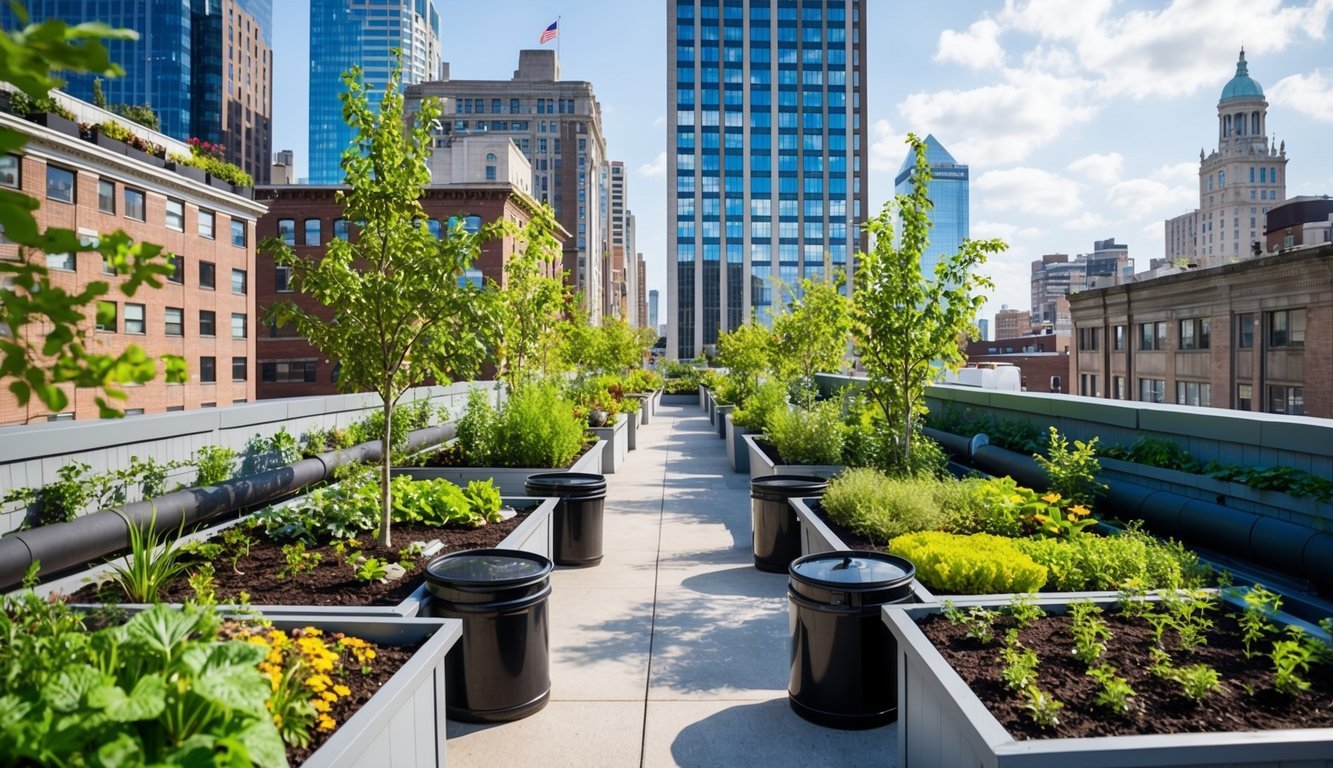
With the right strategies, I can cultivate a vibrant green space that makes a positive impact.
From choosing the right plants to managing resources effectively, sustainable gardening is all about making thoughtful choices that work for my city garden.
1) Plant native species for lower maintenance
Planting native species is one of the best choices I’ve made for my garden.
These plants are naturally suited to my local climate and soil, so they require less water and care.
Since they’ve co-evolved with local insects and wildlife, native plants support a balanced ecosystem.
I appreciate how they attract pollinators like bees and butterflies while keeping pests at bay.
Plants like Yarrow and Missouri violet are perfect for city gardens.
They thrive with minimal interference and can handle urban conditions quite well.
Choosing native species means less time spent on watering, fertilizing, and pruning.
They are resilient and can adapt to the changes in weather, which saves me effort in the long run.
By filling my garden with these plants, I’ve created a beautiful, low-maintenance space that’s in harmony with the local environment.
It’s rewarding to see it flourish with such ease.
Use compost instead of chemical fertilizers
In my garden, I focus on using compost instead of chemical fertilizers.
Compost provides essential nutrients while improving soil health.
It’s a natural alternative that keeps my plants thriving without the risks of chemical runoff.
Making compost is simple.
I collect kitchen scraps, yard waste, and other organic materials.
These break down into a nutrient-rich amendment for my plants.
I aim for a balance of green materials, which are high in nitrogen, and brown materials, rich in carbon.
When I add compost to my soil, I mix it well to enhance its texture and drainage.
It helps retain moisture and encourages healthy root development.
Plus, it’s a great way to recycle waste.
Using compost creates a sustainable cycle in my garden.
I avoid harmful chemicals and support a healthier ecosystem.
This practice not only benefits my plants but also contributes positively to the environment around me.
Harvest rainwater with barrels
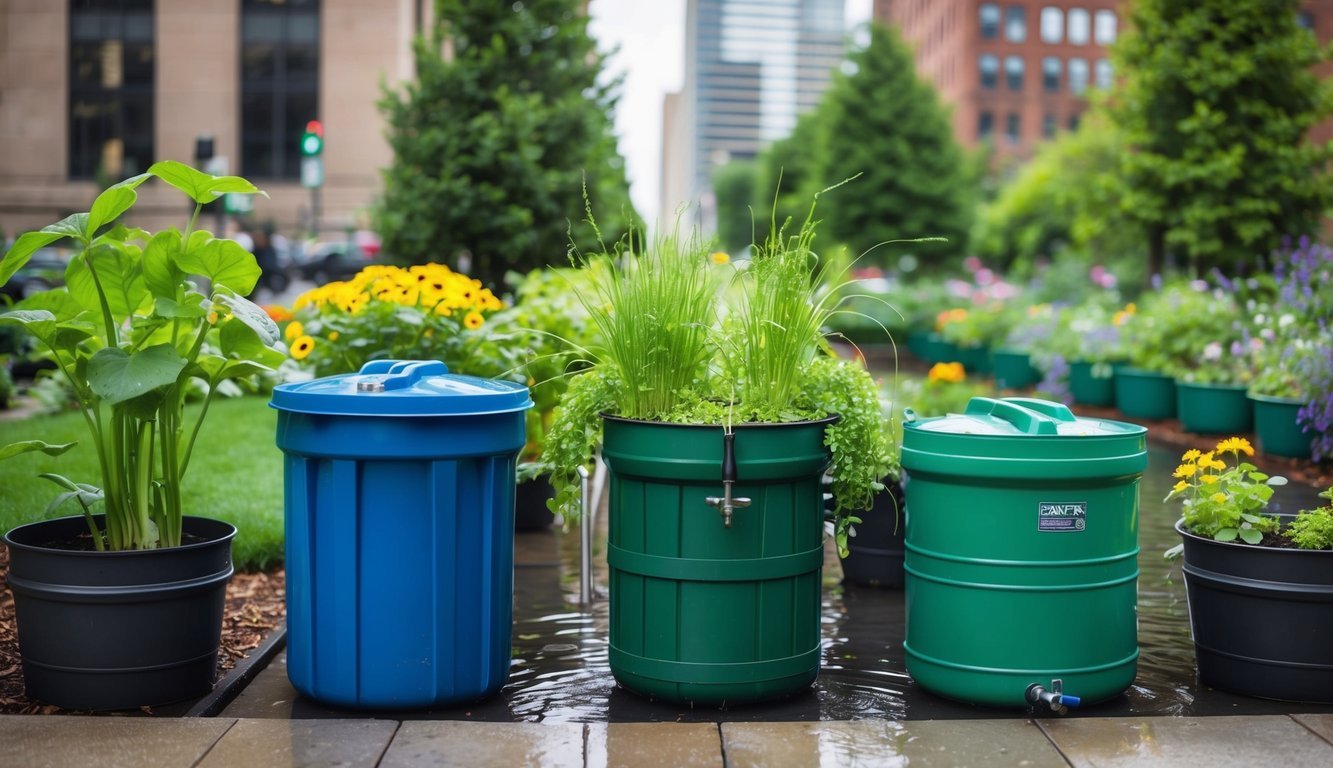
Collecting rainwater is one of my favorite ways to support a sustainable garden.
Using barrels to harvest rainwater is easy and beneficial.
It helps me conserve water and reduce my utility bills.
I set up my barrels beneath the downspouts of my roof.
This way, they catch water directly from the gutters.
It’s essential to use food-grade plastic barrels.
They keep the water clean and safe for my plants.
Regular maintenance is key.
I make sure to check the barrels for debris and clean them out as needed.
A fitted lid helps prevent pests from getting in and keeps the water cleaner.
In addition to conserving water, using rain barrels also helps control runoff.
This practice reduces erosion in my yard and supports overall soil health.
It’s a simple step toward a greener garden that I can feel good about.
4) Grow vertical with wall planters
I love using wall planters to maximize space in my urban garden.
They’re perfect for small areas where traditional gardening isn’t feasible.
Wall planters come in various styles and can hold a variety of plants, from herbs to succulents.
I often use them for vegetables like lettuce and herbs, as they thrive in smaller spaces.
Setting them up is easy.
I choose a sunny spot on a wall and attach the planters securely.
This not only saves ground space but also transforms bare walls into vibrant green areas.
Maintaining wall planters requires regular watering, especially in summer.
I set reminders to ensure my plants get enough moisture.
Using wall planters also adds aesthetic value to my space.
They can create a striking visual display that brightens up my garden.
Plus, growing vertically helps improve air quality, benefiting my whole living area.
5) Select drought-tolerant plants
When I think about starting a sustainable garden, selecting drought-tolerant plants is key.
These plants thrive with minimal water, making them perfect for city living.
I always prefer varieties that suit my local climate.
I usually look for native plants since they are adapted to the area.
They tend to require less maintenance and help support local wildlife.
Long taproot plants, like butterfly weed, are my favorites because they access moisture deep in the soil.
It’s important to avoid thirstier plants that demand lots of water.
I’ve found that focusing on local species not only saves water but also adds beauty to my space.
Mulching around these plants helps retain soil moisture and reduces the need for watering.
Efficient irrigation systems can also work wonders, directing water only where it’s needed.
6) Implement companion planting techniques

I love using companion planting in my urban garden.
It’s a simple way to boost productivity and create a healthier ecosystem.
Certain plants work better together.
For example, I plant basil next to my tomatoes.
The basil not only enhances the flavor of the tomatoes but also helps repel pests.
Marigolds are another great addition.
They deter nematodes in the soil and attract beneficial pollinators.
It’s like having a little army of helpers in my garden.
When planning my garden layout, I consider these relationships.
Grouping compatible plants can enhance growth and reduce the need for chemical pest control.
I’ve noticed that my plants thrive when they are paired thoughtfully.
It makes gardening feel more intuitive and fulfilling.
Plus, I get to enjoy the variety of colors and scents in my garden.
7) Create a pollinator-friendly environment
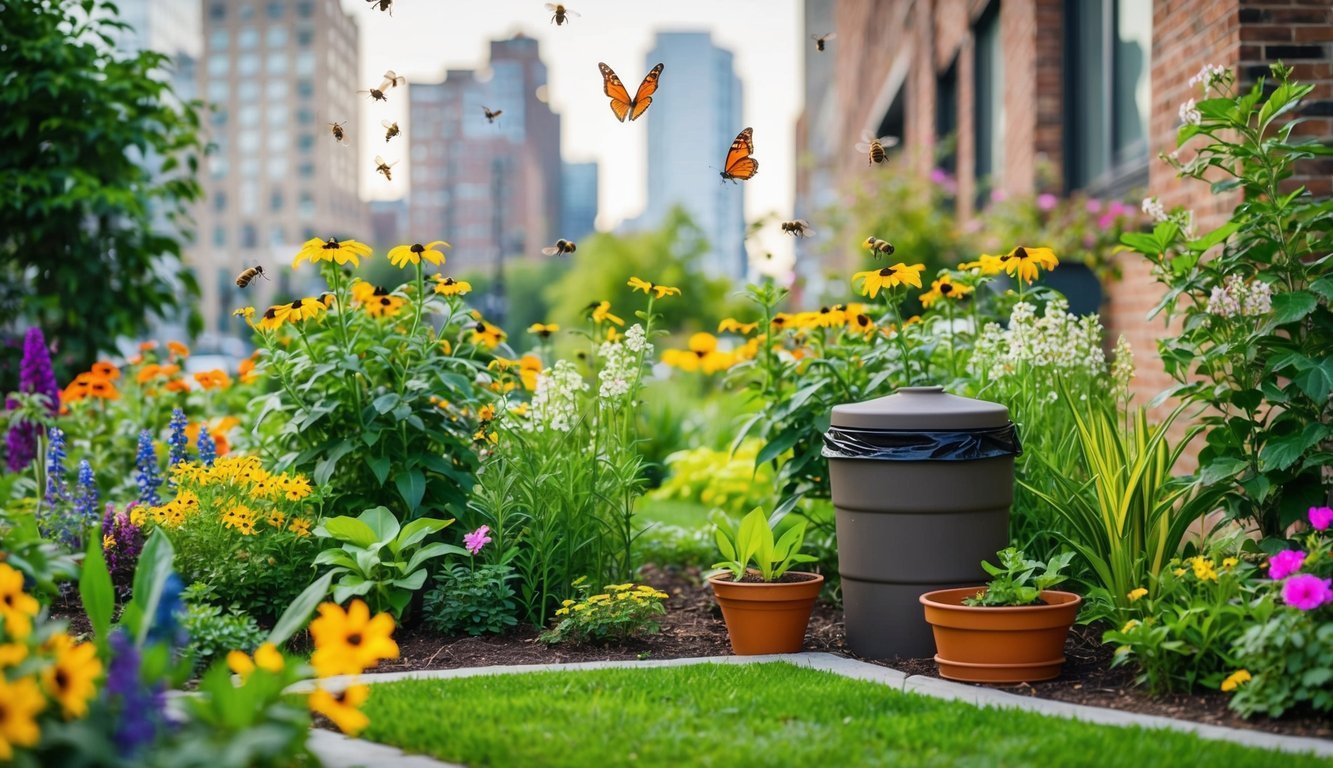
Creating a pollinator-friendly environment is essential for any sustainable garden.
I’ve learned that even small spaces can attract these vital creatures.
I start by planting native flowers.
They thrive in my local climate and naturally draw in butterflies, bees, and other pollinators.
Incorporating a mix of flower shapes and colors also helps.
I love planting blooms that flower at different times, ensuring there’s something for pollinators year-round.
Adding some flat stones can offer a sunny spot for pollinators to rest.
I find that shallow water sources, like birdbaths, are beneficial for hydration, too.
Leaving portions of my garden a bit wild creates habitats.
I avoid doing too much clean-up in the fall, allowing areas where insects can nest.
Lastly, I steer clear of chemical pesticides.
Instead, I embrace beneficial insects that keep my garden balanced.
These efforts make my garden a vibrant space that supports the local ecosystem.
Understanding Urban Gardening
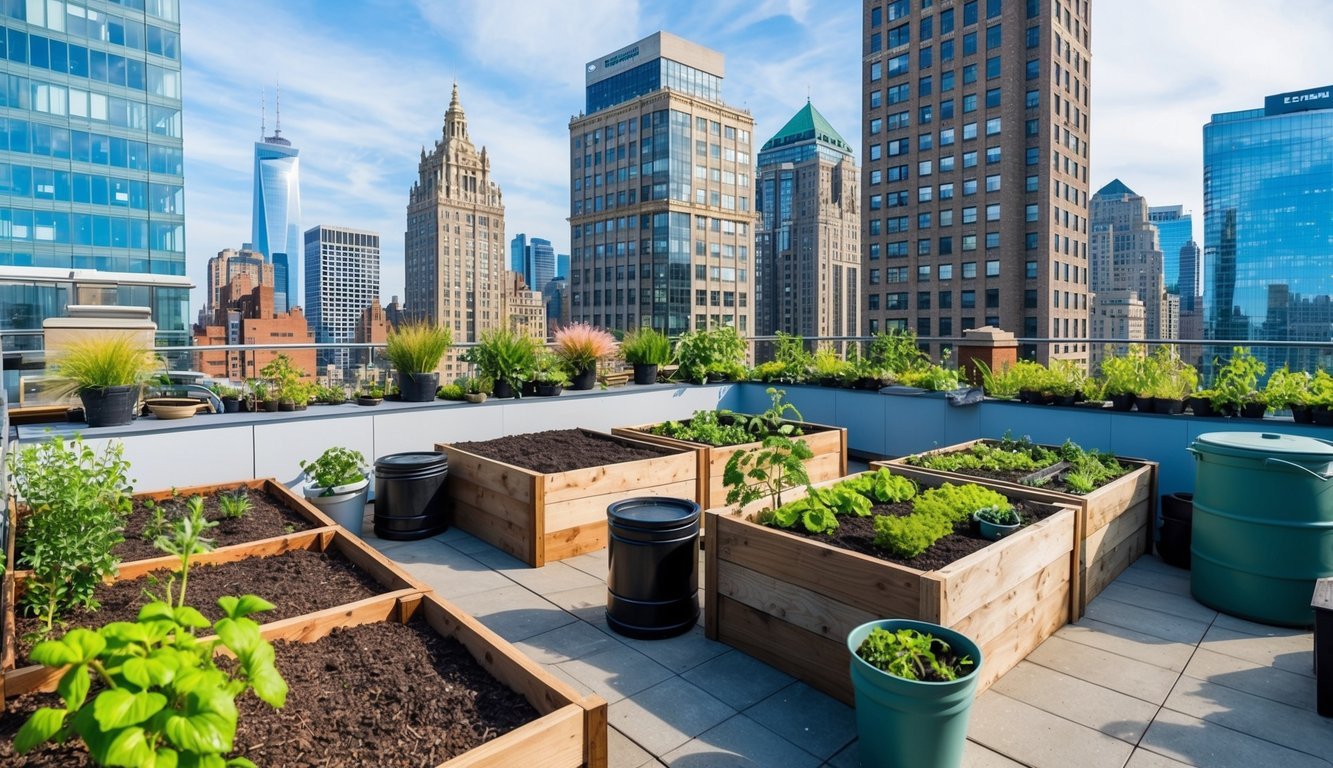
Urban gardening is a rewarding way to engage with nature while living in a city.
It brings fresh produce to my kitchen and offers numerous environmental benefits.
As I explore this topic, I’ll share some key benefits and challenges of cultivating a sustainable garden in urban spaces.
Benefits of Sustainable Urban Gardening
Sustainable urban gardening offers a multitude of benefits that enhance both personal well-being and the urban environment.
-
Fresh Food Access: Growing my own fruits and vegetables means I get access to fresh produce right from my balcony or rooftop.
-
Environmental Impact: Urban gardens can help improve air quality by absorbing pollutants and reducing the overall carbon footprint.
-
Biodiversity: Incorporating native plants into my garden supports local wildlife and pollinators, creating a vibrant ecosystem.
-
Community Engagement: Community gardens foster connections with neighbors and promote education on sustainable practices.
Overall, these benefits help create healthier urban environments while improving my quality of life.
Challenges and Solutions in City Environments
While urban gardening is fulfilling, it does come with its own set of challenges.
Some common issues I face include:
-
Limited Space: Cities often have tight spaces, but I can use vertical gardening techniques or container gardens to maximize my area.
-
Soil Quality: Urban soil may be contaminated. Conducting a soil test and using raised beds with quality soil can mitigate this.
-
Pollution: Air and soil pollution can hinder plant growth. Choosing hardy plants and using organic methods can help, as well as employing rainwater harvesting systems for irrigation.
By addressing these challenges thoughtfully, I can create a sustainable urban garden that thrives despite city limitations.
Soil Management Tips

Maintaining healthy soil is crucial for a successful urban garden.
It helps support plant growth and enhances overall garden sustainability.
Below are some practical strategies for improving soil quality and using organic fertilizers effectively in small spaces.
Improving Soil Quality in Limited Spaces
In confined areas like balconies or small plots, I recommend starting with a quality potting mix.
Look for options enriched with compost, which boosts nutrient content.
Composting is my go-to method for enriching the soil.
I keep a small compost bin for kitchen scraps, yard waste, and other organic materials.
Over time, this transforms into rich compost that greatly enhances my garden soil.
Additionally, I often use mulch to retain moisture and suppress weeds.
Materials like shredded leaves, straw, or bark work well.
Layering mulch also contributes organic matter as it decomposes, giving my plants a consistent nutrient source.
Lastly, I perform soil testing to understand pH levels and nutrient deficiencies.
Products to measure soil quality are widely available and offer insights on how to tailor my amendments for maximum effectiveness.
Using Organic Fertilizers
Switching to organic fertilizers is a game-changer for my garden.
I use products like fish emulsion or liquid seaweed, which provide essential nutrients without the harmful effects of synthetic options.
Compost tea is another excellent organic alternative.
I make it by steeping compost in water, allowing the nutrients to seep in.
This nutrient-rich solution can be applied to plants every few weeks to boost growth.
I also appreciate slow-release organic fertilizers, as they feed plants over time.
Brands containing bone meal or blood meal release nutrients gradually, providing consistent support.
Using these methods keeps my garden healthy and thriving, while also being eco-friendly.
By focusing on natural sources of nutrients, I feel good about my gardening practices and the positive impact on my urban environment.
Water Conservation Techniques
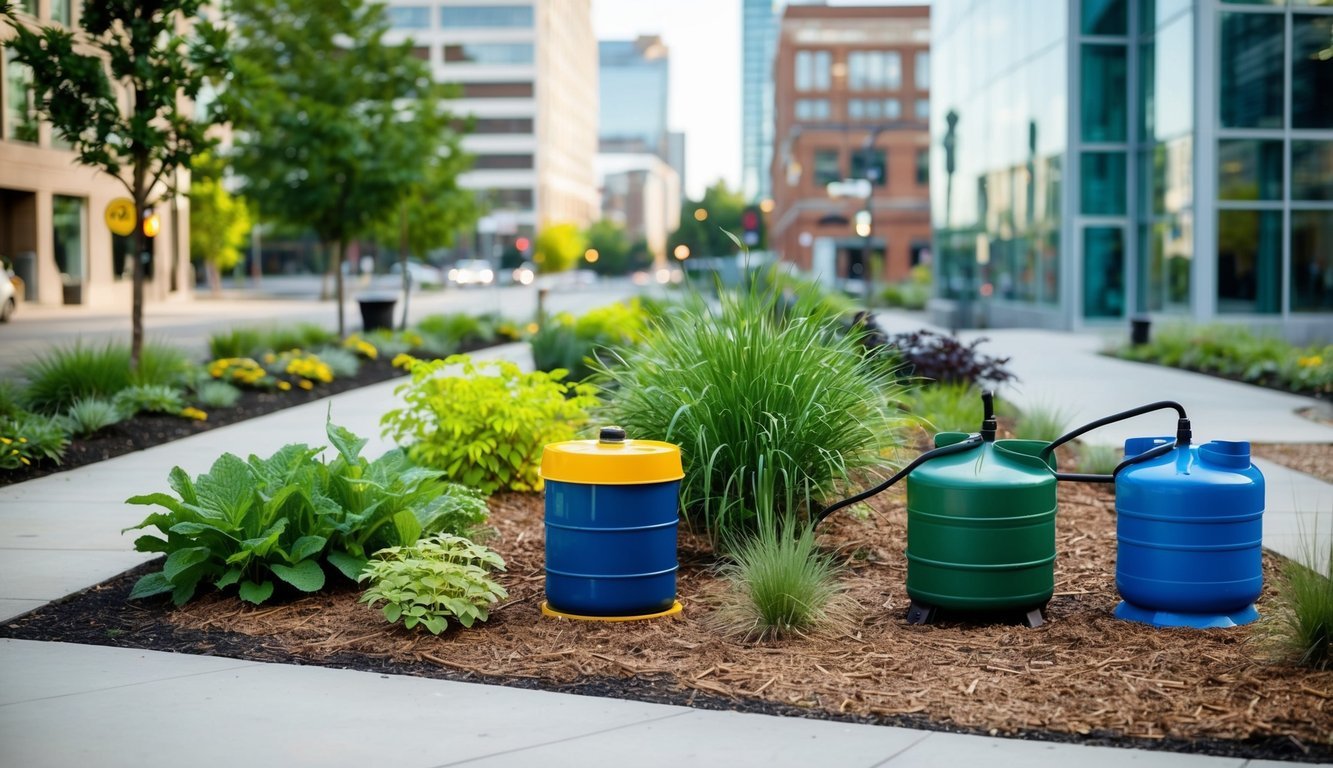
Water conservation is crucial for sustainable urban gardening.
Implementing smart strategies can significantly reduce water usage while keeping my garden healthy and vibrant.
Efficient Irrigation Methods
I focus on efficient irrigation methods to minimize water waste.
Drip irrigation is my go-to choice.
It delivers water directly to the plant roots, reducing evaporation and runoff.
I can set it up on a timer, ensuring my garden gets a consistent supply.
Another method I love is using soaker hoses.
They slowly release water along their length, soaking the soil evenly.
I often combine both methods for maximum efficiency.
Additionally, I make sure to water early in the morning or late in the evening to avoid evaporation during the hot daytime.
Rainwater Harvesting in the City
Rainwater harvesting is a game-changer for my urban garden.
I install rain barrels under downspouts to collect water during storms.
This helps in conserving water and also reduces runoff that can cause erosion.
To make the most of my collected rainwater, I use it for watering my plants and even for filling my compost bin.
I ensure the barrels are covered to prevent mosquito breeding.
By using rainwater, I contribute to a sustainable cycle, making my gardening efforts more eco-friendly.

